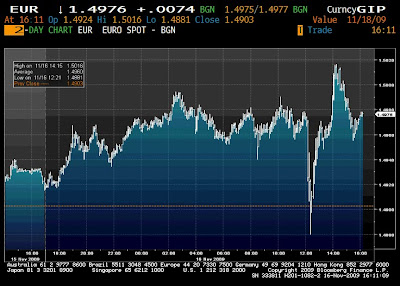We've been talking a lot about the Fed lately so I thought I'd share my version of the Taylor Rule calculation. I've built this myself so it might not exactly track other versions that are out there, but I did follow Taylor's basic methodology. Bear in mind that this isn't meant to predict Fed Funds. I use it more as a reality check. If my Taylor Rule calculation is falling I'm not likely to make a call that Fed Funds is going to be rising.
Anyway, here is a recent chart of the output. Taylor Rule in green, actual Fed Funds target in blue. I took it out to 4Q 2009 assuming that 4Q GDP and CPI comes in equal to Bloomberg's economist survey (3%). Holy liquidity trap Batman! Its sharply negative, suggesting that monetary policy can't get easy enough. Thus it justifies the Fed's current stance.
Holy liquidity trap Batman! Its sharply negative, suggesting that monetary policy can't get easy enough. Thus it justifies the Fed's current stance.
Now consider what it looks like if I carry out the Bloomberg median survey result for both GDP and CPI through 2010.
Suddenly the "correct" Fed Funds level according to my model is 2%, by the first quarter! Will the Fed actually hike by 200bps between now and 1Q 2010? Even assuming that GDP comes in as expected in 1Q, I highly doubt the Fed gets this aggressive. But could they start hiking? I think its possible.
I think readers should consider the following:
- Potential GDP is probably falling due to a less levered economy. That means a lower level of GDP would be considered above potential and thus potentially inflationary. It probably also means a higher level of NAIRU.
- There is room to remain accommodative in policy but be above zero on Fed Funds target.
- The fact that we're far below trend GDP levels doesn't matter. In a Keynesian world, its a question of whether Aggregate Demand is outpacing Aggregate Supply. What Aggregate Demand would have been in 2006 isn't relevant.
- As a trade, if GDP does improve but the Fed doesn't hike at all, then it will be time to put on a bear steepener!








